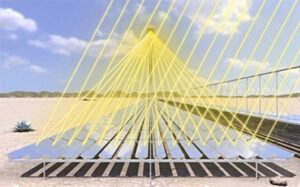“Linear Fresnel – A Concentrating Solar Power Technology to Advance Solar Innovation,” by the National Renewable Energy Laboratory of Golden, Colorado, senior engineering, Guangdong Zhu, Ph.D., will be held on Thursday, October 27, 2016, 3:30 pm, in the Milner Executive Boardroom (0560 MEK).
Linear Fresnel is one of four major concentrating solar power technologies. It utilizes an array of flat or near-flat mirrors to track the sun and concentrate sun light to a fixed receiver assembly. The mirrors are aligned in rows close to the ground and the receiver assembly includes one or mutliple absorber tubes with an optional secondary reflector. A type of heat transfer fluid (such as water/steam and thermal oils) flows through absorber tubes and are heated by solar energy. The fluid outlet temperature may range from 200 °C to 550 °C.
The generated heat from linear Fresnel collectors can be used in various types of applications: 1) By using a thermodynamic power cycle such as steam or organic Rankine cycles, the high-temperature thermal energy can be converted into electricity in utility-scale; 2) Due to the scalability of linear Fresnel technology, it can also be used to provide heating/cooling to commercial buildings or communities of different sizes; 3) Due to the design flexibility of linear Fresnel technology, it can provide an efficient heat source for bioenergy systems to convert the waste into green fuel; 4) linear Fresnel technology can be naturally and economically integrated with water desalination systems to produce clean water.

In particular, the talk will discuss the latest progresses in the development of an innovative linear Fresnel collector design. The new design adopts water-borne mini-size tube reflectors and has a great potential to reduce the current-level collector cost by half. More importantly, NREL has made a breakthrough in secondary reflector optimization and the new optimization method is able to greatly improve the collector optical efficiency. At the same time, the mechanical design of receiver assembly is carried out by using sophisticated CFD and heat transfer modeling.
At last, the speaker will discuss his vision on how to combine linear Fresnel technologies and other renewable energy technologies to sustain off-grid communities.
Biography:
Dr. Guangdong Zhu has been a senior research engineer in the concentrating solar power (CSP) program of the Buildings & Thermal Systems center at the National Renewable Energy Laboratory (NREL) since 2010. At NREL, he is leading research efforts related to linear Fresnel technology, solar collector optical characterization and solar hybridization with other types of energy systems. Prior to joining NREL, Dr. Zhu worked in industry and had worked on optimization, prototyping and engineering of advanced molten salt concentrating solar systems. Dr. Zhu obtained his Ph.D. from the University of New Mexico.
His ongoing research projects are focused on low-cost innovative solar collector developments, solar/geothermal hybridization research, drone-driven non-intrusive optical characterization method of solar field and geothermal power plant modeling. His project funding agencies and partners include DOE’s solar energy program and geothermal technology office, California Energy Commission, Southern California Gas Company, Hyperlight Energy, University of Colorado at Boulder (CU), and University of Illinois Urbana-Champaign (UIUC). He is also serving in the technical advisory committee of UCLA’s innovative thermal energy project funded by the California Energy Commission. He has published about forty peer-reviewed papers, reports, and presentations in the areas of renewable/traditional energy systems, thermal science, multiphase flow and non-imaging optics.